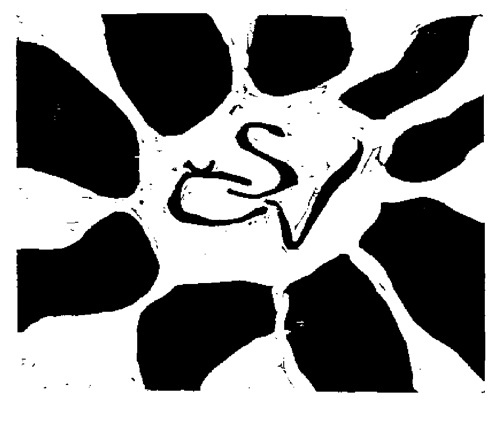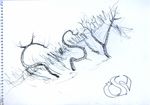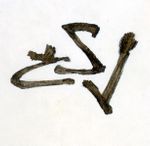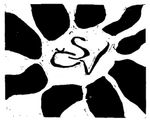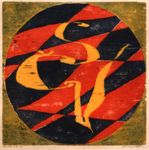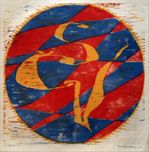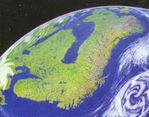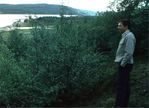ČSV. Čájet Sámi Vuoiŋŋa! A look at one of the most important symbols of Sámi revitalization in the early 1970-ies.
Artists lead on in an important initiative that soon becomes a symbol of unity and strength for a threatened and vulnerable Indigenous people.
Although this is a brief summary of some important events since the late 1960ies, we have to mention the first inter-Nordic Sámi Conference of reindeer owners taking place at Troandin 06. 02.1917 initiated by a charismatic activist Elsa Laula Renberg of Vaapste, hence the Sámi National Day every year on this date in honour of her initiative. From then there has been many ups and downs, marked by brave Sami individuals as well as a few non-Sámi, to act against the mainstream of assimilation and attempted cultural genocide in Fennoscandia, like so many other regions of our globe. Many Sámi artists were in the front, Anders Fjellner, Anders Larsen, Johan Turi with Emilie Demant-Hatt, to name but a few from the past. Then there were Paulus Utsi, Lars Pirak, Nils Aslak Valkeapää, and Maj Lis Skaltje among the most versatile.
The Nordic Sámi Council had been founded in 1956, yet the first international Conference took place in Johkamohkki 31.08. – 03.09. 1953. (Snoase/Snåsa 26. – 28.06.1974) the first Nordic Sámi parliament was opened in Finland 9. November 1973, and later in Norway and Sweden.
Using unacceptable means (threats, exaggerations and plain lies) Mr Hans Rønbeck managed to convince many Sámi to go against their own people, signing a document stating that Sámit did not want separatism, or anything that would lead to Reservations, as in America, and that efforts to strengthen the Sámi society, culture or language were unnecessary. Opposing this were the leaders of NSR, who aimed for ethnic, cultural, economic and poilitical survival and equality by peaceful means.
This man was just one in a large row of non-Sámi trying to take advantage, abuse or patronize us, in order to grab our resources more easily, and render us incapable of protest. Still worse was it when some among us did the same, and advocated self-denial as a sole means of national salvation. Most famously in our recent history is Mr Henrik Ravna, whose activity prompted a French newspaper to write: “The Sámit are the only people on earth that do not wish to survive”.
But even this could not stop the revitalization process.
The Sami Searvi/Samisk Selskap in Oslo (1947) was the beginning of the NSR (1968). There are now national cultural and political organisations in all 4 countries with indigenous Sámi population, including, among others the Guládaga Sámi Searvi (1989).
‘ČSV’ as a specific Sámi slogan had been initiated at a Sámi political preparatory meeting at Máze authumn 1970, then threatened by a huge river dam. Johan Jernsletten of Buolbmát threw out the idea half jokingly with the mention of “Secret Sámi Helper” “čiegus Sámi veahka” and from that time onwards, it developed into something very special and powerful.
The important seminar on Sámi Literature at the village of Sirbmá by the beautiful Deatnu River in authumn 1972 was a demonstration of the will of our people to fight against destructive forces from without and within. This was in a time when the anti-Sámi major of Kárásjohka, now the seat of the Sámi Parliament, and thus our “capital”, had the power to do great harm to the budding Sámi activism and will to survive. However, according to Johan Klemet Hætta Kalstad, the ČSV was initiated already in 1970, at a political meeting in Máze. Litteraturseminar in Sirbmá 1972 encouraged Sámi writers to use their language, which were published through a series of booklets, Čállagat. There has been some confusion as to the origin of the cover: the design for the cover is made by the Sami teacher Marit Stueng of Kárašjohka, who also used it as decoration and flag to promote Sámi activism. Anders Guttormsen, editor of the Sámi periodical NUORTTANÁSTE and writer of books, suggested additional content to the ČSV symbol of the new spirit in Sámi culture, one of active optimism replacing fear and shame.
More about this theme here (Sámi with English summary):
The slogan should be many sided, and at least one “Sámi” letter should be in it, “Č” in addition “S” for Sámi was self-evident, and “Čále Sámigiela vuokkasit!” made the third and last letter a “V”, thus “ČSV”, which became a symbol for the Sámi language, literature, culture and positive activism in general. The symbol was very flexible, and it was up to the users fantasy and creativity to make slogans from these three letters, like Čájet Sámi Vuoiŋŋa! and similar encouraging sentences. Needless to say, some made ridiculed of it, and found some funny sayings for it, but at least it showed the flexibility of Sámi culture.
The first Sámi Publishing company Jår’galæd’dji (‘Translator’) OS by Odd Ivar Solbakk & Aage Solbakk, 1974, starting as music publishers with a famous if not sensational Long Playing Record DEATNUGÁDDE NUORAT (Youth from Deatnu Riverbank) Tanabreddens Ungdom LP, that had a huge impact also on the non-Sámi populations, who suddenly discovered some of the positive sides of Sáminess. 2 of the yoik-inspired songs were on the national hit list for years. This company published numerous books, & language courses (Dávvin/Sámas), not to forget Vulle Vuojáš (Donald Duck in Sámi).
One important TV-program about the Sámi revitalization in the early 1970-ies, was called 'ČSV – vis at du er same!'(ČSV – show your Sámi pride!) focusing on Knut Johnsen of Fanasgieddi, Deatnu and produced by Sámi producers for the national TV. I was an art student in Oslo at that time, and remember one old distinguished Norwegian gentleman who exclaimed: “This program has to be stopped!”(“Det programmet må stoppes!”). On another occasion I saw the same person in connection with a royal visit, and he asked, “Where are the court?” “Hvor er hoffet? Hvor er hoffet?” I told him, there is no court in Norway, but he just continued, clearly not accepting certain facts of history. I did not see him at the first demonstration against the Alta dam in 1978 as it was voted on in Parliament in its sad favour, the formal starting point of the so called Alta-conflict. .
These were some of the first steps in the Sámi revitalization that still goes on, as least as long as artists like me are alive and kicking!
Some additional information:
The first documented use of ČSV as a written greeting (as far as my own correspondence is concerned, of course) was at the end of a letter to Samernas Folkhögskola in Johkamohki, Sápmi, Sweden 11.05.1973. I used ‘ ČSV’ several times that year, including for a letter to Chief Elijah Smith, President of the Yukon Native Brotherhood, Canada, explaining the meaning of the ČSV symbol; it was used in all 12 times that year, 5 times the folloowing year, in 1975: 7, 1976: 4, 1977:1; 1978: 0; 1979: 2; 1980: 1; 1981: 4. I may have used it a few times later, but generally it was in most use, I believe, during this period, at least by the ČSV-pioneers, and I was one of them.
My student friend from Deatnu, Knut Johnsen was involved in making the first TV documenation about Sámi activism, preparing for the sole Norwegian State Channel a program called « Č SV- vis at du er same» that was eventually screened 17.10.1974, with at least one reprise. It was an eye-opener, a challenge and a provocation to the multiufaceted attitudes to ethnic diversity within the country’s population, Sámi and non-Sámi alike.
During the preparations, we were working on some kind of visual presentation of the symbol itself, and in co-operation with Nufte, as Knut was called in Sámi, we worked out what appeared in the program. Here is a letter about that to Knut Johnsen, dated Oslo, 06.10.1973:
Første gang ČSV opptrer i min korrespondanse var i et brev til Samernas Folkhögskola i Johkamohki 11.mai 1973, og i alt brukte jeg det skriftlig 12 ganger det året, inkludert i et brev til Chief Elijah Smith, President of the Yukon Native Brotherhood, Canada, med forklaring på symbolets mening; videre i 1975: 7 ganger, 1976: 4, 1977: 1 (var utenlands), 1978: 0, 1979: 2, 1980: 1 og 1981: 4. HAr nok brukt det sporadisk flere ganger senere, men vil anta at denne perioden var bruken størst, iallfall blant hva som kanskje kan kalles ČSV-pionerene, og jeg tillater meg å regne meg med blant disse.
En annen Tanaværing og student Knut Johnsen var involvert i produskjonen av et planlagt televisjonsprogram om den pågående samiske revitalisering « ČSV – vis at du er same» som ble vist på den eneste statskanal den gang, NRK TV den 17. oktober 1973. Det ble en provokativ, informativ og inspirerende visualisering av den økende sameaktivisme i nord. Jeg var også involvert, i og med at jeg laget forslag til en plakat med ČSV-symbolet, som jeg hadde utarbeidd, og som ble vist i programmet. Her er et brev datert 6.okotber 1973 som kan indisere dette, om noen skulle være i tvil:
Hei Nufte!
Tusen takk for hyggelig brev. Det er gått lang tid før jeg svarer, dessverre. Beklager, men nå skriver jeg jo.
Jeg er enig med deg i at Č SV -bokstavene kommer litt dårlig fram, hva kan gjøres med det? En mulighet er jo å kutte ut gulfargen i bakgrunnen og la rødt overta også den, slik at det bare blir rødt og blått i bakgrunnen. Mest blått må det bli. Så kunne bokstavene være i gult, helst en litt varm gul (dvs. gul som ligger nærmere rødt enn blått). Da skulle bokstavene kommet godt nok frem. En annen ting er jo om dere kan bruke forslaget i det hele tatt. Har du kontaktet de merke-folkene?
Du skjønner, jeg har hatt det så veldig travelt i denne siste tiden. Dessuten har jeg søkt på Statens Kunstakademi, og kommet inn på grafikk-linja! Var ikke det bra? Av ca. 110 som søkte kom 30 inn.
Jeg sender deg et helt nytt forslag, dvs. ideen er den samme, men bokstavene er forandret. Gjør som du vil, enten du bruker dette eller det forrige.
Jeg husker du skrev at du sku en tur hit te byen, men jeg har ikke sett deg. Jussi sa det samme, men han har jeg ikke sett, skjønt jeg vet at han har vært her.
Endelig begynner jeg å komme til ro igjen. Jeg gleder meg til å få opptaket av ditt stykke som du fremførte på NSR.
Kunne du tenke deg å oversette til samisk noe av det jeg har skrevet? Vel, jeg er iallfall frekk nok til å spørre. Har vært på Oslo Sami Særvi-møte. De tok opp blant annet den nye dikt-samlinga ” Čallagat”, har du sett den?
Ha det riktig godt, Nufte, håper du skriver.
Vennlig hilsen og Č SV ! Hans Ragnar.
This was more the practical side of it. Simultanoeusly I wrote at some length in a letter to another friend Silba-Áilu, Aslak Siri about the meaning of the symbol, as I conceived it at the time:
Dette omhandlet de mer praktiske sidene av symbolet, og i et annet brev samme dag til den første samiske sølvsmed Aslak Siri fra Guvdageaidnu, ggår jeg mer inn på betydningen av symbolet slik jeg oppfattet det dengang:
<Aslak Siri, 9520 Guovdageaidnu Oslo, 06.10.1973
Hei, Sil’ba-Ailo!
Takk for sist! Det var nesten trist for meg å måtte dra fra Kautokeino, jeg liker meg så godt der. Her i Oslo går det ganske bra med meg, får jeg si: jeg søkte om å bli opptatt på Statens Kunstakademi. Stod i en uke og tegnet akt, dessuten skulle vi (110 stykker) levere en del av våre egne bilder. Jeg søkte på grafisk og kom inn! Sånt er det, og det er meget hyggelig. Mer fritt, og mer individuell undervisning. Dessuten: jeg slipper å ta opp lån, men får tilsvarende i stipend, dvs. ca. 10.000 kr. pr. år i fire år. Men jeg tar ett, kanskje to år av gangen. Grunnen til at jeg sender Č SV -forslagene først nå er at jeg ikke har kunnet finne dem før nå i alt rotet mitt. Dessuten har jeg hatt så mye å gjøre. Men nå er jeg kommet mer til ro. Når kommer du hit ned?
Vi snakket litt om Č SV og hva det står for. Det er jo meget vanskelig. Det er jo et identitetsmerke for de som føler seg som samer. Men hva er det å føle seg som samer? Vel, det må jo være å ikke føle seg som f.eks. nordmann. Kanskje vi der skal ta utgangspunktet. Hva er det hos nordmenn eller i det norske samfunn som ofte virker frastøtende på samer?
Generelt kan det vel sies at det norske språk er hårdere, mer som slag og nesten stikk, mens det samiske språk er som klapp uten dermed å være svakt nødvendigvis, iallfall ikke sykt, hvis du skjønner. I det norske, eller vestlige samfunn er det jag etter penger, berømmelse (forsiktig nå), status og statussymboler (bil, hytte, pelskåpe osv.) mens det blant samer iallfall før het at: penger kom og gå, men bygg ikke rede.
Menneskekjærlighet og nestekjærlighet er sterkere i det samiske samfunn. Slektsfølelse er sterk. Jeg har inntrykk at samer helst vil være i slekt med alle, eller de fleste andre samer, enten de bor her eller der.
Blant (oss) samer er kanskje det spontane mer utbredt, men også den avbalanserte ro når noe er inntruffet.
Dumdristighet tror jeg forekommer mer blant andre, samene har lært å innrette seg etter realitetene. Så lenge disse ikke er for ille. I en situasjon som mange har opplevd, eller måttet oppleve slik som fornorsking og alt det fører med seg, er samene mer eller mindre blitt assimilert, eller de har resignert, eller rett og slett blitt sinnslidende og i verste fall begått selvmord. Dette er kjente fenomen blant andre minoriteter i samme situasjon.
Samekulturen har likevel maktet å overleve århundreders press fra folk som både av andre og seg selv er regnet for mye sterkere, i det minste fordi de er flere. Mange flere.
Hva er det da i det samiske samfunn som har greidd å trosse dette? Det kan simpelthen være stahet, stahet i positiv betydning. En stahet som er grunnet på at hvis jeg har rett, så lar jeg meg ikke overvinne av noe eller noen, få eller mange. Det er en slags trofasthet mot det samiske, som er nedarvet i generasjon etter generasjon. Troskap mot det gamle og det de stod for er noe av kjernen her, tror jeg.
Samene forkaster ikke en tradisjon, før de har prøvd om det ”nye” virkelig er bedre, og da først. Noe annet er hva de er tvunget til.
Hvordan ville det være om samene var fri for tvang, kunne da samisk kultur overleve? eller ville den stivne til og dø ut? kanskje den ville utvikle seg enda bedre? ikke vet jeg. Men all kultur utvikler seg ”under kamp” med andre kulturer. Derfor er det svært viktig at man ikke godtar hva som helst.
…
Sender deg altså prøven på Č SV -merket jeg har sendt som forslag til Nufte.
…
Ha det godt, Bures boattin Osloi!
Č SV Hans Ragnar
I will conclude my essay about the Č SV symbol by telling an incident that turned out slightly different than expected. I was meeting Chief of the National Indian Brotherhood of Canada George Manuel and also the President of the World Council of Indigenous Peoples since 1975, in the summer of 1976 (June 4th) in Ottawa. He told me he was soon going to attend the Nordic Sámi Council Meeting, and asked me if there were some kind of slogan or encouraging saying he could end his planned speech with. I immediately thought about “ ČSV!” as a fit conclusion. But I told him that I was in doubt also, and made it very clear that there are some people even among the Sámi that regarded the ČSV as too radical, and not representative for all Sámit. But in the end I thought he ought to take that chance. The young Sámi activists would need the encouragement it would be that a world Indigenous leader used the ČSV symbol in their own homeland, despite the fact that some would react negatively. This reveals how the priginal and utterly positive content of thre symbol, had gradually turned into something almost untouchable for some, aven among the Sámi, a development that had been caused by the very harsh opposition from Scandinavian individuals and grpoups, including government and Secret Police. To many of them ČSV was a symbol for a hidden underground movement, aimed at revolution and a Sámi take-over, aided by outside powers like the Basques, AIM (American Indian Movement) and worst of all, the Soviet Union. Most of this was fantasy and pure specualtions, rooted in loose observations of flirtation with such ideas on the part of some extrovert acticvists. I myself met a Russian whose job iot was obviously to contribute to such speculations, but hat was many years later. I met George Manuel after the Conference, and he told me I had given him a bad advice. He cite Aslak Nils Sara, the leader of the Nordic Sámi Council, saying that “When you said « ČSV !» the young liked it, but you lost the old ones. I think that might be a precise description of what happened. But I felt it was too harsh to blame it on me, or was it? Maybe this was one reason for the distance that seemed to establish itself between me and them? Was I wrong in suggesting the use of ČSV? At least it proves my belief in ČSV .
Jeg vil avslutte mitt skrift om ČSV-symbolet med å fortelle hva som skjedde da jeg hadde besøkt Presidenten for WCIP, Verdensrådet for Urbefolkninger, George Manuel, av Interior Salish-folket i vest-Canada, i Ottawa 4. juni 1976. Han fortalte at han skulle ha en tale på Nordisk Samekonferanse senere på året, og spurte om jeg kunne foreslå en passende avslutningsappell på sitt innlegg. Jeg tenkte selvsagt på ČSV! som en passende konklusjon, og forklarte ham uttale, betrydning og historikk. Jeg gjorde ham oppmerksom på at det nå av mange, også samer ble ansett som problematisk, men begrunnet denne skepsis som et resultat av hets og negative holdninger og mistenkeliggjøring fra majoritetsbfolkningenes side. ČSV-symbolet har altså måttet gå igjennom en ildprøve av forakt og mistenkeliggjøring fjernt fra den aktive optimisme den var sprunget ut fra. For mange representerte dette en hennelig politisk organisering med sikte på revolusjon, med hjelp av krefter utenfra, samene hadde jo kontakt med Baskere, AIM (American Indian Movement) og ikke minst Sovjetunionen. Dette ble tatt svært alvorlig av Etterretningen i landet, til manges forbauselse. De brukte mye ressurser på papir, og for mange som hadde opplevd forholdene under Nazi-tiden et par, tre tiår tidligere var dette skremmende nok.
Neste gang jeg traff George Manuel, fortalte han meg at jeg nok ikke hadde gitt ham et så godt råd, og siterte leder for Nordisk Sameråd Aslak Nils Sara, ”Da du sa «ČSV!» likte nok de unge det, men du mistet de gamle!”. Jeg syntes nok at han var noe vel bebreidende, og minnet ham på hva jeg hadde sagt om at det var en risk, men verdt å ta. Kanskje dette var grunnen til at de ble en avstand mellom disse og meg. Var det galt av meg å foreslå ČSV? Innerst inne mener jeg nok at det var riktig, men det er jo mulig jeg tar feil. Hva mener dere? Uansett, ingen kan påstå at jeg ikke var ČSV-er…
Cecilie de Lange 02.08.2021 11:27
Hei - jeg lurer på en ting. Kjenner du til en logo for CSV med en hånd der det står saami resistance? og aner du når den er fra (årstall?)
Hans Ragnar Mathisen 05.08.2021 19:37
Nei, har aldri sett den før
Lars-Nila Lasko 09.01.2016 11:12
Mer information om Anders Fjellner, hans poesi och betydelsen av hans arbeten finns p Samiska Historiebloggen: www.samiskhistorieblogg.wordpress.com
Se även lä
Nyeste kommentarer
28.09 | 07:36
Hei! Jeg skal kjøpe inn trykk til en større kunstforening og er interessert i dett...
18.09 | 10:32
Hei har prøvd å kontakte deg tidligere men kan ikke se å ha fått svar. Jeg lur...
12.09 | 08:56
Kan noen si meg hvordan jeg kan komme i kontakt med deg HR Mathisen f...
23.08 | 07:10
Varme gratulasjoner med St. Olav! Vel fortjent! Husker tilbake på mange g...





